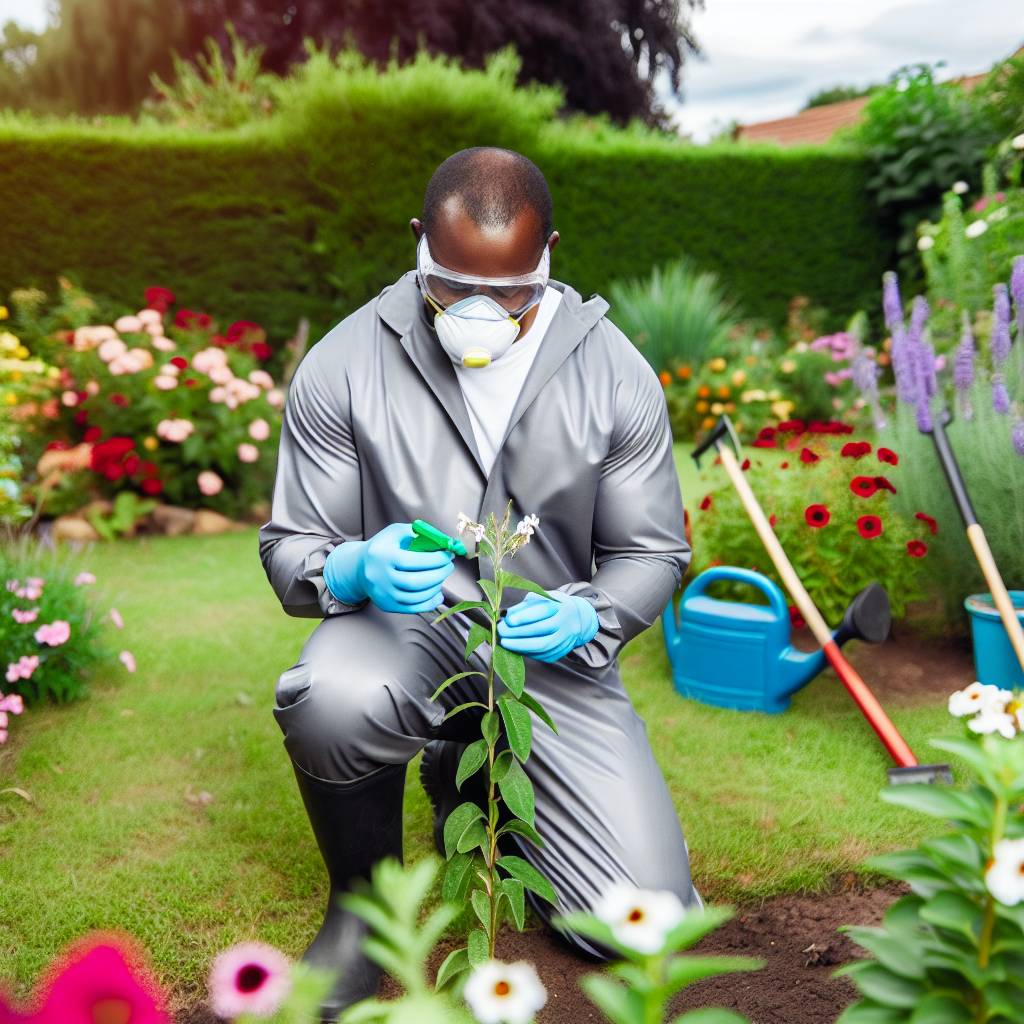Introduction to Integrated Pest Management
Integrated Pest Management, or IPM, is a strategic approach to pest control.
It combines various management strategies to minimize pest populations.
The relevance of IPM in real estate landscaping is significant.
Landscapes are essential for enhancing property values and aesthetics.
Without proper management, pests can damage these landscapes.
IPM provides a holistic way to prevent and control pest issues.
First, it emphasizes understanding the pest’s life cycle and behavior.
This knowledge helps in developing effective management practices.
Second, IPM relies on monitoring pest populations regularly.
Landscapers can identify when intervention is truly necessary.
Additionally, IPM incorporates a mix of cultural, biological, and chemical strategies.
Cultural practices include proper irrigation and plant selection.
By using resistant plant varieties, landscapers can reduce pest attraction.
Biological controls introduce natural enemies of the pests.
However, chemical controls are sometimes essential.
Transform Your Agribusiness
Unlock your farm's potential with expert advice tailored to your needs. Get actionable steps that drive real results.
Get StartedThey should be used as a last resort.
This balanced approach minimizes environmental impact.
Moreover, it reduces reliance on chemical pesticides.
This is beneficial for nearby ecosystems.
Consequently, implementing IPM can lead to healthier landscapes.
In turn, these landscapes boost property appeal and value.
Effective pest management also ensures the safety of people and pets.
Overall, IPM is a smart choice for real estate landscaping.
It promotes sustainability while maintaining landscape aesthetics.
In the long run, it can save costs associated with pest damage.
The Economic Benefits of Implementing IPM in Landscaping Projects
Cost Efficiency through Reduced Pesticide Use
Integrated Pest Management (IPM) lowers overall pesticide costs.
It encourages the use of natural pest controls over chemicals.
Consequently, property owners save on expensive chemical purchases.
Additionally, reduced pesticide usage decreases application costs.
Enhanced Property Value and Aesthetic Appeal
Landscaping managed with IPM enhances property appearance.
Beautiful landscapes attract potential buyers and renters alike.
Moreover, an appealing landscape can increase a property’s market value.
Long-Term Sustainability and Reduced Liability
IPM fosters long-term health of landscape ecosystems.
Sustainable practices reduce risks associated with pest outbreaks.
This approach minimizes future property maintenance expenditures.
Furthermore, property owners mitigate liabilities associated with chemical runoff.
Community and Environmental Benefits
Implementing IPM contributes positively to the local community.
It supports biodiversity by protecting beneficial insects and pollinators.
As a result, communities enjoy healthier ecosystems.
Showcase Your Farming Business
Publish your professional farming services profile on our blog for a one-time fee of $200 and reach a dedicated audience of farmers and agribusiness owners.
Publish Your ProfileAdditionally, IPM practices advocate for environmentally responsible management.
Improved Client Relations and Marketing Opportunities
Utilizing IPM can improve client satisfaction for landscaping businesses.
Clients appreciate eco-friendly practices that IPM promotes.
This positive image can become a significant marketing tool.
As a result, businesses attract environmentally conscious clients.
Environmental Advantages of IPM in Maintaining Healthy Landscapes
Promoting Biodiversity
Integrated Pest Management (IPM) encourages diversity in landscapes.
This diversity supports various plant and animal species.
Healthy ecosystems thrive with a variety of organisms.
Moreover, increased biodiversity enhances natural pest control.
Reducing Chemical Usage
IPM prioritizes preventive measures over chemical treatments.
This approach significantly lowers pesticide applications.
Consequently, it minimizes the risk of chemical exposure.
Moreover, reduced chemicals lead to safer living environments.
Enhancing Soil Health
Healthy landscapes benefit from IPM’s focus on soil health.
This method promotes sustainable soil management practices.
Healthy soil supports robust plant growth and resilience.
Additionally, it improves water retention and reduces erosion.
Conserving Water Resources
IPM strategies often emphasize efficient water usage.
By conserving water, landscapes maintain healthy plants.
Effective irrigation practices contribute to sustainability.
Furthermore, reduced water waste protects local ecosystems.
Improving Air Quality
Less chemical use contributes to better air quality.
IPM practices reduce odor and airborne pollutants.
As a result, communities experience cleaner air and a healthier environment.
Fostering Long-term Sustainability
IPM aims for ecological balance in landscape management.
This approach fosters long-term environmental health.
Additionally, it strengthens resilience against climate change impacts.
IPM promotes sustainable practices essential for future generations.
See Related Content: How Farmland Sustainability Impacts Real Estate Investment Returns
How IPM Impacts Property Value and Curb Appeal for Real Estate
Enhancing Curb Appeal
Integrated Pest Management (IPM) significantly enhances curb appeal.
By focusing on environmentally friendly practices, properties look healthier and more inviting.
Well-maintained landscapes attract potential buyers or renters.
Moreover, vibrant and thriving plants create a welcoming atmosphere.
Improving Property Value
IPM practices prevent pest-related damage that can reduce property value.
Real estate with a reputation for effective pest management commands higher market prices.
Investors recognize the benefits of sustainable landscaping in maintaining property value.
Reducing Long-Term Costs
IPM strategies minimize the need for costly chemical treatments.
This approach leads to lower maintenance and operational costs over time.
Moreover, properties become more self-sustaining, freeing up resources for other improvements.
Attracting Eco-Conscious Buyers
Today’s homebuyers increasingly favor eco-friendly practices in property management.
Showcase Your Farming Business
Publish your professional farming services profile on our blog for a one-time fee of $200 and reach a dedicated audience of farmers and agribusiness owners.
Publish Your ProfileImplementing IPM shows a commitment to environmental sustainability.
Properties that utilize these methods can appeal to a broader audience.
Creating a Healthier Environment
IPM fosters a safer, healthier environment for residents and visitors.
This approach reduces exposure to harmful chemicals and pesticides.
Consequently, it enhances the outdoor experience for everyone involved.
You Might Also Like: How to Balance Soil pH for Effective Fertilizer Absorption
Case Studies Showcasing Successful IPM Implementations in Residential Landscaping
Residential Community in Green Valley
The Green Valley community faced severe pest infestations.
In response, they adopted an Integrated Pest Management (IPM) approach.
They implemented regular monitoring to identify pest populations early.
This proactive strategy allowed them to reduce pesticide use significantly.
As a result, the community saw an increase in beneficial insect populations.
Homeowners reported improved plant health and vibrant landscapes.
Consequently, property values increased due to the enhanced curb appeal.
Yorktown Gardens
Yorktown Gardens struggled with aphid infestations on flowering plants.
The management decided to engage an IPM consultant.
They introduced biological controls, such as ladybugs, to control aphids naturally.
This method successfully reduced reliance on chemical pesticides.
Moreover, the gardens became a safe haven for local wildlife.
Visitors appreciated the more diverse ecosystem within the gardens.
Feedback indicated higher satisfaction rates among community members.
Sunny Acres Development
Sunny Acres was known for its beautiful landscaping but faced pest issues.
The developers took a comprehensive IPM approach to address these challenges.
They began by educating landscapers and residents about pest identification.
In addition, they encouraged scouting practices to catch infestations early.
They also employed trap cropping to divert pests from main crops.
This strategy led to healthier plants and reduced chemical interventions.
Consequently, residents noted lower maintenance costs over time.
Tranquil Gardens HOA
The Homeowners Association of Tranquil Gardens faced invasive weed problems.
They created an IPM plan focusing on prevention and early detection.
They utilized mulching to suppress weed growth effectively.
Furthermore, they promoted native plants that enhance soil and biodiversity.
This approach reduced the need for herbicides significantly.
Overall, the community enjoyed lush, healthy landscapes without negative impacts.
Residents expressed gratitude for the eco-friendly initiatives.
Discover More: Common Weed Types That Impact Agricultural Land Value

IPM Strategies for Sustainable Real Estate Landscaping
Understanding Integrated Pest Management
Integrated Pest Management, or IPM, focuses on sustainable practices in landscaping.
This approach balances pest control with environmental health.
The goal is to reduce reliance on chemical pesticides.
Choosing Native Plants
Native plants are well-adapted to local climates and soil conditions.
They require less water and fertilizer than non-native species.
Showcase Your Farming Business
Publish your professional farming services profile on our blog for a one-time fee of $200 and reach a dedicated audience of farmers and agribusiness owners.
Publish Your ProfileMoreover, they attract local pollinators and wildlife.
This biodiversity can aid in natural pest control.
Regular Monitoring and Assessment
Regular site assessments identify pest problems early.
This proactive approach reduces infestations before they escalate.
Moreover, monitoring helps maintain plant health and aesthetics.
Implementing Cultural Practices
Cultural practices can significantly impact pest populations.
For example, proper irrigation minimizes disease risk.
Additionally, mulching can suppress weed growth.
These methods help create a healthier landscape overall.
Utilizing Biological Control Methods
Biological controls involve using natural predators to manage pests.
For instance, ladybugs can control aphid populations effectively.
Furthermore, introducing beneficial nematodes can target soil pests.
This method enhances the ecological balance in landscapes.
Incorporating Mechanical Controls
Mechanical controls involve physical methods to deter pests.
These can include traps and barriers to protect plants.
Additionally, regular maintenance, such as pruning, prevents infestations.
Education and Stakeholder Involvement
Educating developers and landscapers about IPM is vital.
Training programs can promote sustainable practices effectively.
Involving property managers ensures consistent implementation of IPM strategies.
Engaging with Local Community
Community engagement strengthens the IPM approach.
Residents can monitor and report pest problems early.
Additionally, educational workshops can promote sustainable landscaping.
Such initiatives foster a collective effort towards environmental stewardship.
Uncover the Details: Choosing the Right Irrigation System for Farming Landowners
Challenges and Barriers to Adopting IPM in the Real Estate Sector
Lack of Awareness
Many real estate professionals lack an understanding of IPM practices.
This lack of awareness creates skepticism towards integrated pest management.
Moreover, outdated pest control methods are often preferred.
High Initial Costs
Implementing IPM can require significant upfront investment.
Real estate developers may hesitate due to budget constraints.
This situation impedes the adoption of more sustainable landscaping practices.
Resistance to Change
Resistance to change is common in established businesses.
Many companies feel comfortable with traditional pest control methods.
Consequently, they may view IPM as unnecessary.
Regulatory Hurdles
Regulations on pesticide use vary by location.
Complex regulations can complicate IPM implementation.
This uncertainty discourages real estate companies from adopting IPM.
Limited Resources
Access to qualified professionals is often a barrier.
Many real estate companies lack staff trained in IPM strategies.
Without proper resources, it is difficult to implement IPM effectively.
Monitoring and Evaluation Challenges
Many companies struggle with monitoring pest populations.
Showcase Your Farming Business
Publish your professional farming services profile on our blog for a one-time fee of $200 and reach a dedicated audience of farmers and agribusiness owners.
Publish Your ProfileEffective evaluation of IPM strategies is essential for success.
Lack of data can lead to poor decision-making in pest management.
Future Trends in IPM and Landscaping for Real Estate Sustainability
Emerging Technologies
Emerging technologies are shaping integrated pest management (IPM) practices.
For instance, drone technology enables precise pest monitoring.
Additionally, artificial intelligence streamlines data analysis for pest management.
This technology allows for real-time responses to pest threats.
Focus on Native Plant Landscaping
Native plants promote biodiversity and support local ecosystems.
Landscaping with native species reduces the need for chemical treatments.
Furthermore, these plants are more resilient to local pest pressures.
Consequently, they contribute to sustainable real estate practices.
Climate-Resilient Landscaping
Climate change necessitates adaptive landscaping strategies.
Landscapers are incorporating drought-resistant plants into designs.
This approach conserves water while enhancing property appeal.
Moreover, it reduces maintenance costs for real estate owners.
Community Involvement and Education
Engaging the community is essential for IPM success.
Property managers can host workshops to educate residents.
These sessions can promote awareness of sustainable practices.
Empowered residents often make better landscaping choices.
Regenerative Practices
Regenerative landscaping goes beyond sustainability.
It aims to restore ecosystems and improve soil health.
This practice can enhance property values in urban environments.
Additionally, regenerative methods create lush, attractive landscapes.
Collaboration with Local Governments
Local governments play a crucial role in promoting IPM.
They can offer resources and support for real estate developers.
Collaboration may lead to higher sustainability standards for landscaping.
Ultimately, this benefits both the environment and property owners.
Additional Resources
No, We Don’t Just Need to Plant More Milkweed – Monarch Gardens
Reconciling agricultural productivity and environmental integrity: a …




